Belfast City Tramways
History
Belfast Corporation became a tramway owner during 1900, when it opened a number of extensions to the Belfast Street Tramways Company network, which it then leased to the company. The corporation probably always intended to bring the tramways under municipal control and operate them itself, and in 1902, negotiations took place with the company to purchase the undertaking; however, the corporation's valuation fell short of the company's, so no agreement could be reached at that time.
The corporation's attitude to the BSTCo hardened, and in 1904, it successfully sought powers to compulsorily purchase the undertaking. The corporation took control on the 1st January 1905, with the BSTCo receiving compensation following arbitration, which was around 10% less than the corporation had offered three years before. A short spur into the Belfast and County Down Railway's Queen Street Station was acquired at the same time, this being owned by the railway company rather than the tramway company.
The corporation set about converting the system to electric traction, including much doubling of single lines, all of which it did 'en masse', rather than on a line-by-line basis, so the disruption was significant. The first electric service commenced on the 30th November 1905, with the last horse tram running a mere four days later on the 4th December 1905.
Following a long, drawn-out process, the corporation finally took control of the only remaining Belfast-area tramway in private hands — the Cavehill and Whitewell (a subsidiary of the British Electric Traction Company) — on the 1st June 1911.
A significant expansion of the system took place on the 29th January 1913 with extensions along Donegall Road, Botanic Avenue, Stranmillis Road, Ligoniel, Castlereagh Road and Bloomfield Road, after which little happened in this regard until the 1920s, when a series of smaller extensions were built (Stormont, Killeen Avenue, Dundonal, Chichester Street and Ballygomartin).
In the late 1920s, the tramway was subject to intense unregulated bus competition, which had serious financial consequences, exacerbated by a law which effectively prevented the corporation from subsidising loss-making services. Matters were only resolved by new bye laws, which were heavily challenged, and a spirit of compromise, which eventually led to all parties reaching agreement on the corporation's area of control. The agreement included the transfer — to the corporation — of buses and bus routes within the municipality, all of which ensured that the trams were shielded from direct bus competition. On the 1st January 1929, and in order to better reflect its enlarged remit, the name of the department was changed to Belfast Corporation Tramways and Motors Department.
The corporation obtained powers to operate trolleybuses in 1930, though it was not until the 28th March 1938 that the first route was opened. This first route proved such a success, that just over ten months later (in January 1939), the corporation decided to abandon the tramways. It also changed the concern's name once again — on the 1st January 1938 — this time to Belfast Corporation Transport Department.
The Second World War put paid to the initial five-year abandonment plan, and it was to be just over fourteen years before the last tram ran, on the 28th February 1953. It is sobering to consider that even as late as 1948, and with a much reduced network, the trams were still carrying almost as many passengers as the buses and trolleybuses combined.
At its greatest extent, Belfast Corporation's tramway system extended to 51.54 miles, comprising lines to: Belmont and Knock in the east; Cregagh Road and Ormeau Road in the south; Malone Road, Balmoral and Andersons Town in the southwest; Springfield Road in the west; Ligoniel and Cliftonville in the northwest; and Chichester Park and Greencastle in the north.
Uniforms
Belfast Corporation operated horse-tram services for approximately twelve months, from its takeover of the Belfast Street Tramways Company on the first day of 1905, to the final run on the 4th December. Existing photographs are difficult to date precisely, but those shown below strongly suggest that the corporation was content for tramcar crews to continue wearing the same attire as they had done under the company, namely: single-breasted jackets and overcoats (probably self-purchased), along with kepi-style caps bearing individual metal numerals.
Belfast City (Corporation) Tramways electric tramcar crews (motormen and conductors) appear to have worn the same basic style of jacket throughout the system's almost half century of service. The jackets were double-breasted with five pairs of buttons (bearing a monogram of 'BCT' initials — see link), three pockets at hip/waist level (with flap closures) and lapels; the jacket collars bore system initials — 'B.C.T.' — in embroidered block capitals, on both sides. Whilst the jackets always carried five pairs of buttons, with the top pair buttoned between the lapels and the collars, in later years the bottom four pairs of buttons became much more closely spaced, conferring a decidedly naval appearance on the jackets. The tensioned-crown peaked caps bore standard,'off-the-shelf, script-lettering grade badges — either 'Motorman' or 'Conductor' — above which an employee number was worn (in individual numerals). The badges were almost certainly brass to match the buttons.
In the late 1930s or 1940s, a switch was almost certainly made to chrome insignia, a change which probably coincided with the introduction of underlined grade badges — 'Motorman' and 'Conductor', and later on 'Driver' — a pattern that was only rarely used by UK tramway operators. Towards the very end of the system's life, the grade badges appear to have been superseded by a one-piece, chrome, 'BCT' block-initials badges.
Motormen and conductors were also issued with double-breasted greatcoats with high, fold-over collars; the latter carried embroidered, block-capital system initials on each side.
Unfortunately, photographs of Belfast City Tramways inspectors have proven elusive, so it is currently impossible to state what uniforms they wore; however, it is believed that the peaked caps bore an oval cloth badge bearing the grade and system initials — 'INSPECTOR' and 'BCT' — embroidered in bullion thread.
Whilst the vast majority of UK tramway systems employed women during the Great War to replace male staff lost to the armed services, there is no evidence that Belfast ever did, nor does it appear to have done so during the Second World War either.
Further reading
For a history of the system, see 'Belfast Corporation Tramways, 1905-1954' by J M Maybin; Light Rail Transit Association.
Images
Horse tram drivers and conductors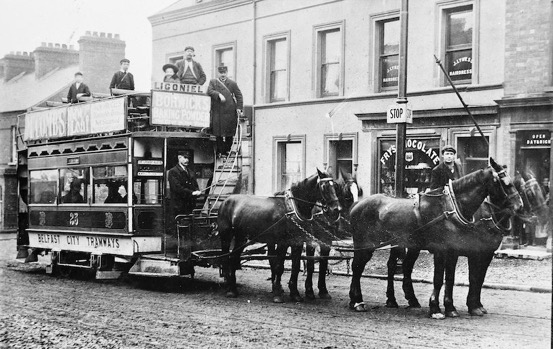
An excellent study of Belfast City Tramways Horsecar No 23 taken in 1905, so after the corporation take-over. The car is still in the livery of the erstwhile Belfast Street Tramways Company. With thanks to the National Tramway Museum. 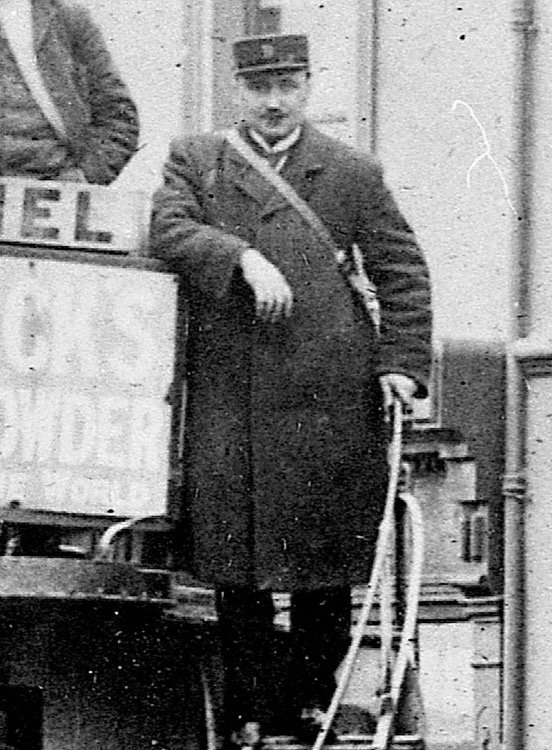
An enlargement of the above photograph showing the conductor. His attire appears to be the same as worn in company days, namely, a single-breasted overcoat (probably self-purchased) and a kepi-style cap bearing a metal employee number.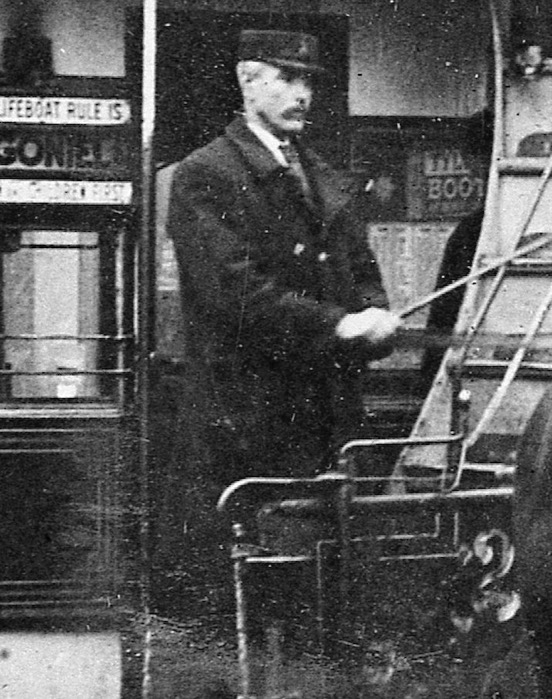
Another enlargement of the above photograph, this time showing the driver, once again in smart overcoat and with a kepi-style cap.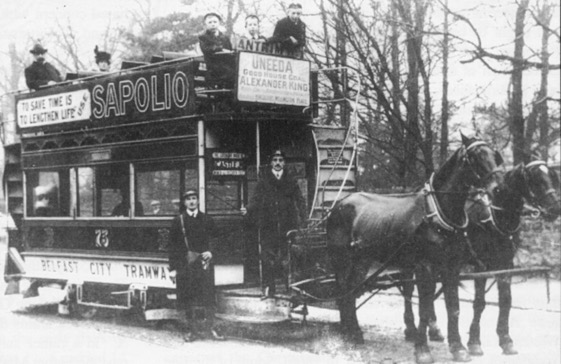
The crew of Horsecar No 73 pose for the cameraman at Fortwilliam Park on the Antrim Road route on the last day of service, 4th December 1905. Both men are wearing smart overcoats and kepi-style caps. Photo courtesy of the Tramways and Light Railway Society, with thanks to David Voice.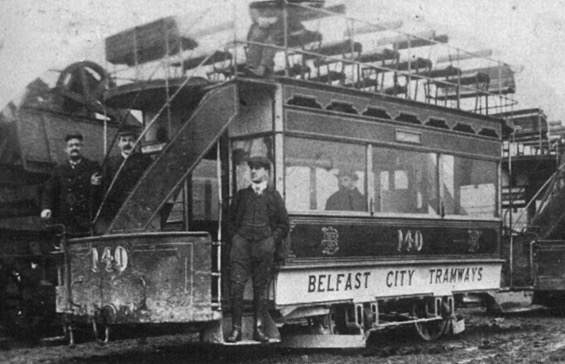
A rather battered Horsecar No 140 standing in Yorkvale Road station goods yard after horse services had ceased, and possibly awaiting shipment to Cork. The uniformed men on the platform are therefore almost certainly railway employees. Photo courtesy of the Tramways and Light Railway Society, with thanks to David Voice.
Motormen and conductors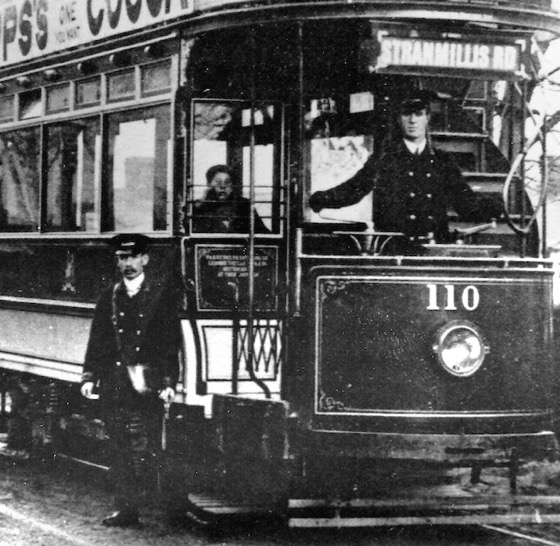
The crew of Tramcar No 110, pictured at the Greencastle terminus on the first day of services on this route, 5th December 1905. Both men are wearing tensioned-crown peaked caps bearing script-lettering grade badges, though the specifics cannot be made out on this particular photograph. Photo courtesy of Jim Kilroy, tram archivist at the National Transport Museum (see link).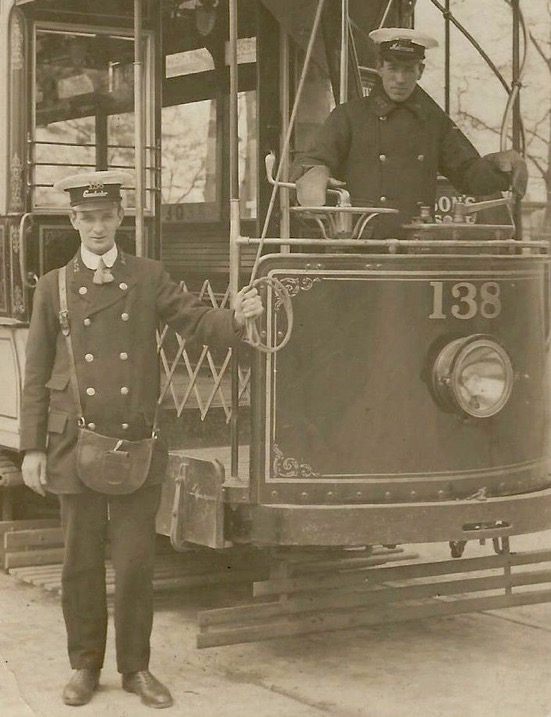
The crew of what would appear to be a nearly new Tramcar No 138 pose for the cameraman — photo undated, but probably taken in 1906. Source unknown.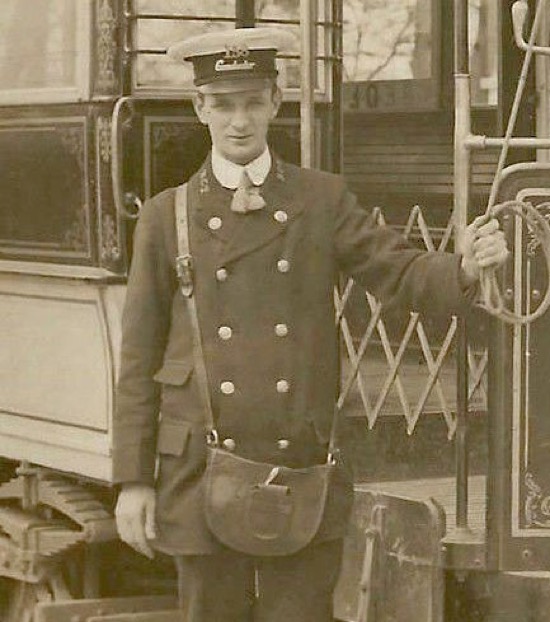
An enlargement of the above photograph showing the conductor. The collars of his jacket bear embroidered system initials, whilst his cap carries an off-the-shelf, script-lettering grade badge — 'Conductor' — and an employee number, '158'.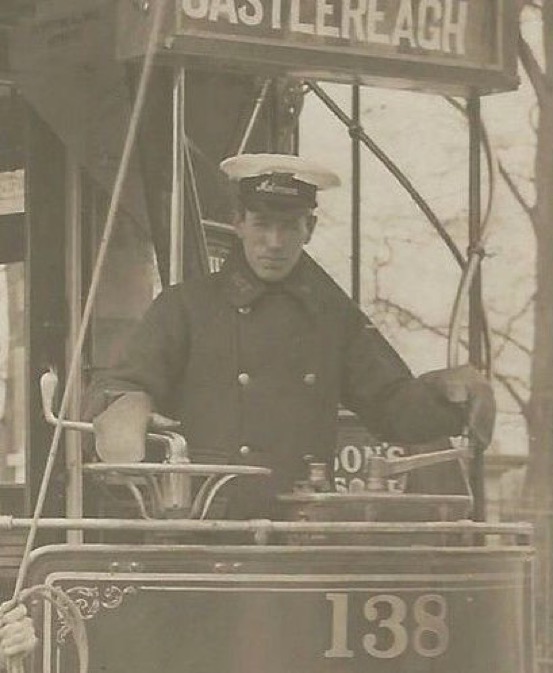
Another blow-up of the above photograph, this time of the motorman, who is wearing a greatcoat with high, fold-over collars, clearly embroidered with block-capital system initials; his grade badge is 'Motorman'.
Standard off the shelf, script-lettering grade badges of the type used by Belfast Corporation Tramways on tramcar-crew caps — brass. Author's Collection.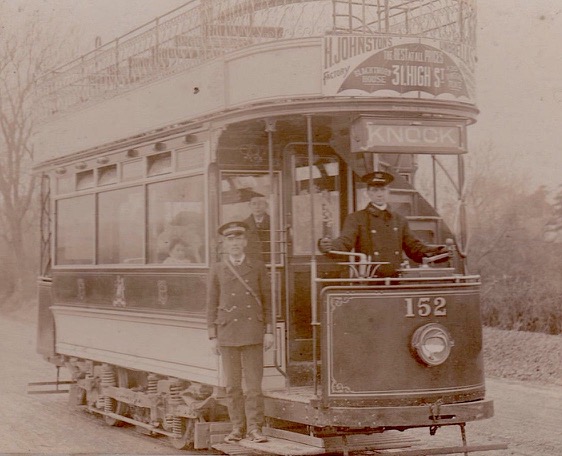
A conductor and a motorman with Tramcar No 152 on a Knock service — photo undated, but probably late Edwardian. The conductor would appear to be wearing a light-coloured hatband, something not seen in other photographs. Source unknown.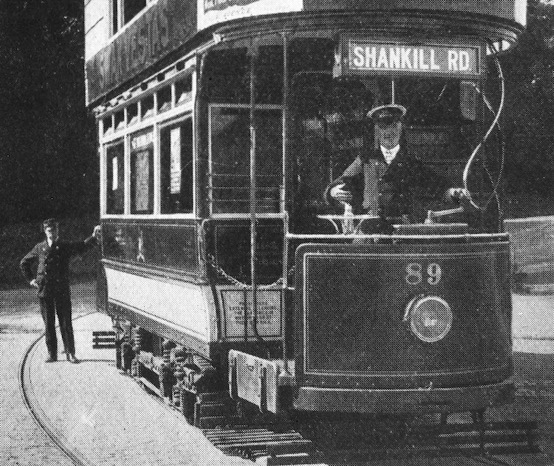
The crew of Tramcar No 89 pose for the camera in 1923. The style of jacket appears unchanged from that introduced at the inauguration of electric services in 1904. With thanks to the National Tramway Museum. 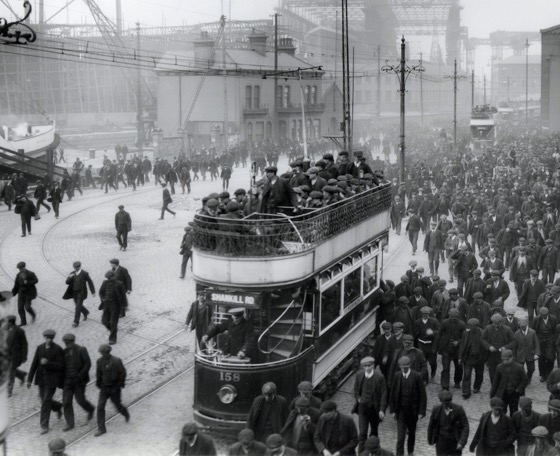
A rather evocative scene outside one of Belfast's shipyards at the end of a shift — photo undated, but probably taken shortly before the Great War. The motorman is wearing a double-breasted greatcoat. Photo courtesy of the Tramways and Light Railway Society, with thanks to David Voice.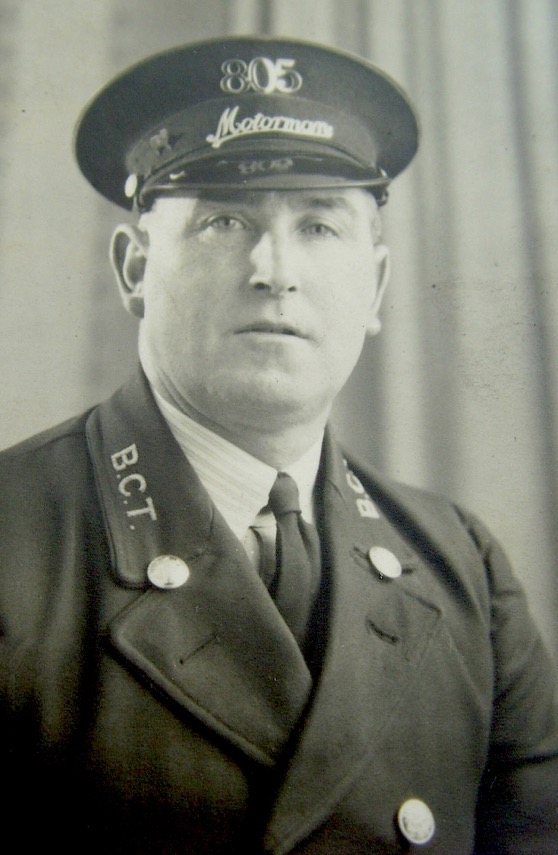
A fine studio portrait of a Belfast Corporation Tramways motorman — photo undated, but probably taken in the 1940s or 1950s. His cap carries an employee number (805), along with a script-lettering grade badge; the latter is underlined, which probably reflects the late date, the vast majority of UK tramway operators only using badges without underlining. The buttons are the 'BCT' monogram type (see link). Stephen Howarth Collection.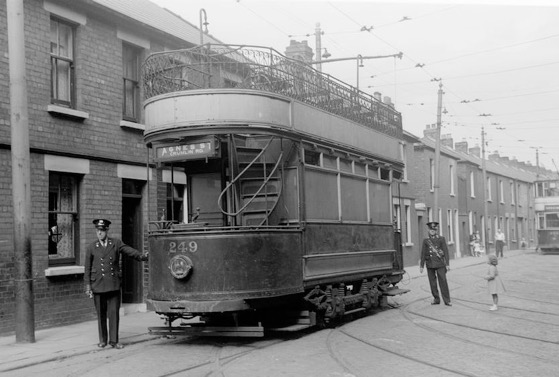
A rather battered-looking Tramcar No 249 outside what is probably the shed fan in Gaffikin Street — photo undated, but possibly taken in 1953 by M J O'Connor. With thanks to the National Tramway Museum. 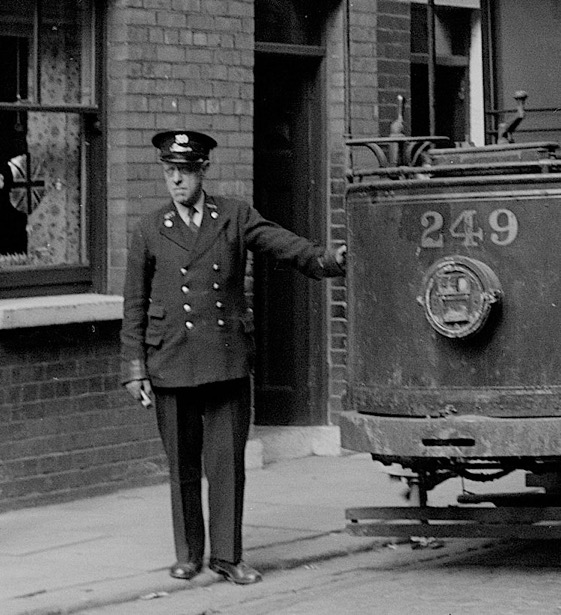
An enlargement of the above photograph showing the motorman. He appears to be wearing a standard script-lettering 'Driver' cap badge (possibly underlined), above which is an employee number, possibly 369.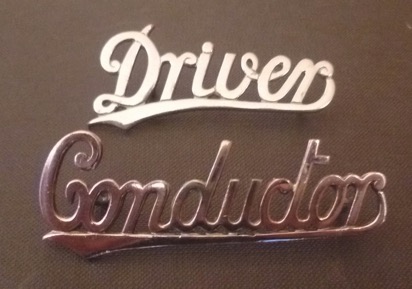
Script-lettering 'Driver' and 'Conductor' cap badges, of the type used in later years by Belfast Corporation Transport — chrome. Author's Collection.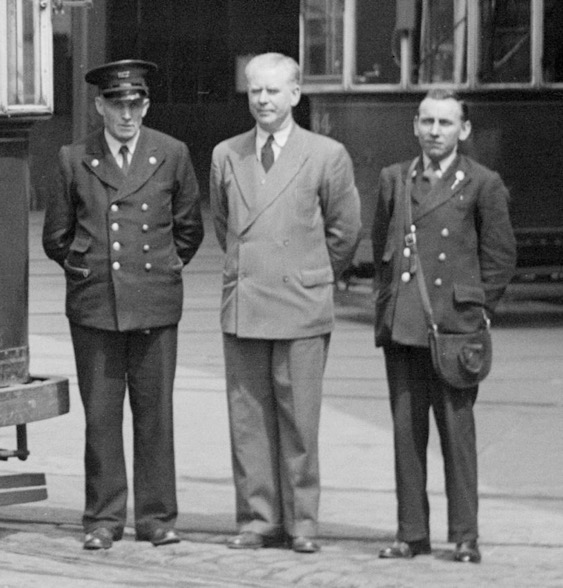
A nice crew shot taken by M J O'Connor alongside Tramcar No 340 at Mount Pottinger depot on 6th June 1953. With thanks to the National Tramway Museum. 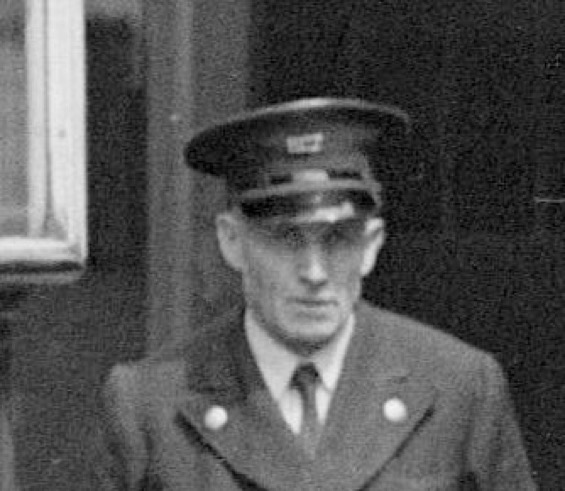
An enlargement of the above photograph, which clearly shows that the motorman is wearing a one-piece, block-capital, system initials cap badge.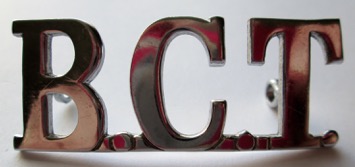
BCT system-initials badge — chrome. These were used a cap badges in later years. Stephen Howarth Collection.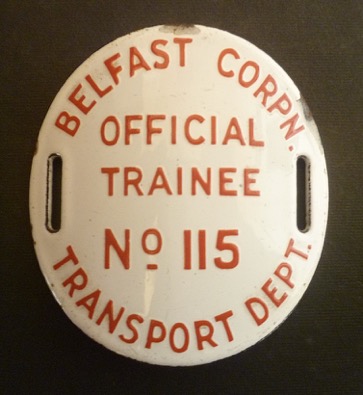
Belfast Corporation Transport 'Trainee' armband — red on white enamel. Probably worn from 1938 onwards. Author's Collection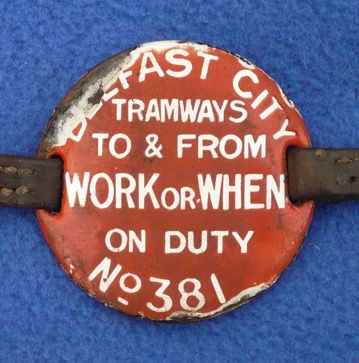
Enamel armband pass. Author's Collection.
Senior staff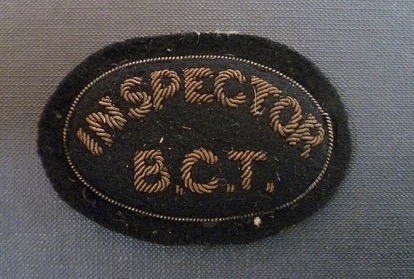
Probable Belfast Corporation Tramways inspector's cap badge — cloth and bullion thread. Author's Collection.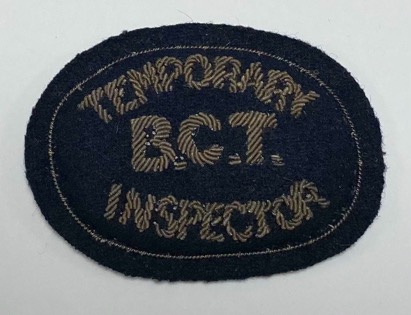
Belfast Corporation Tramways temporary inspector's cap badge — cloth and bullion thread. With thanks to the National Tramway Museum.